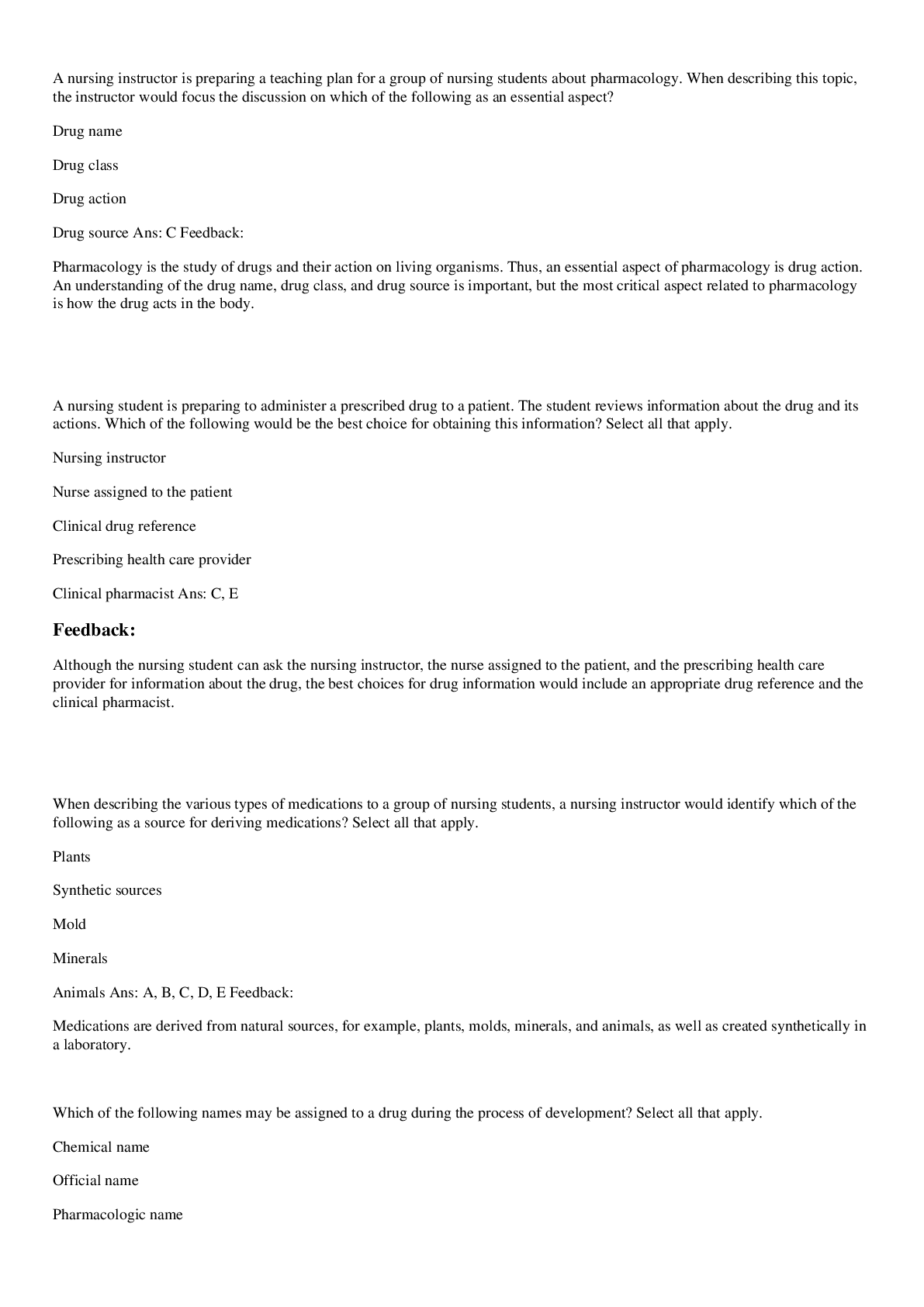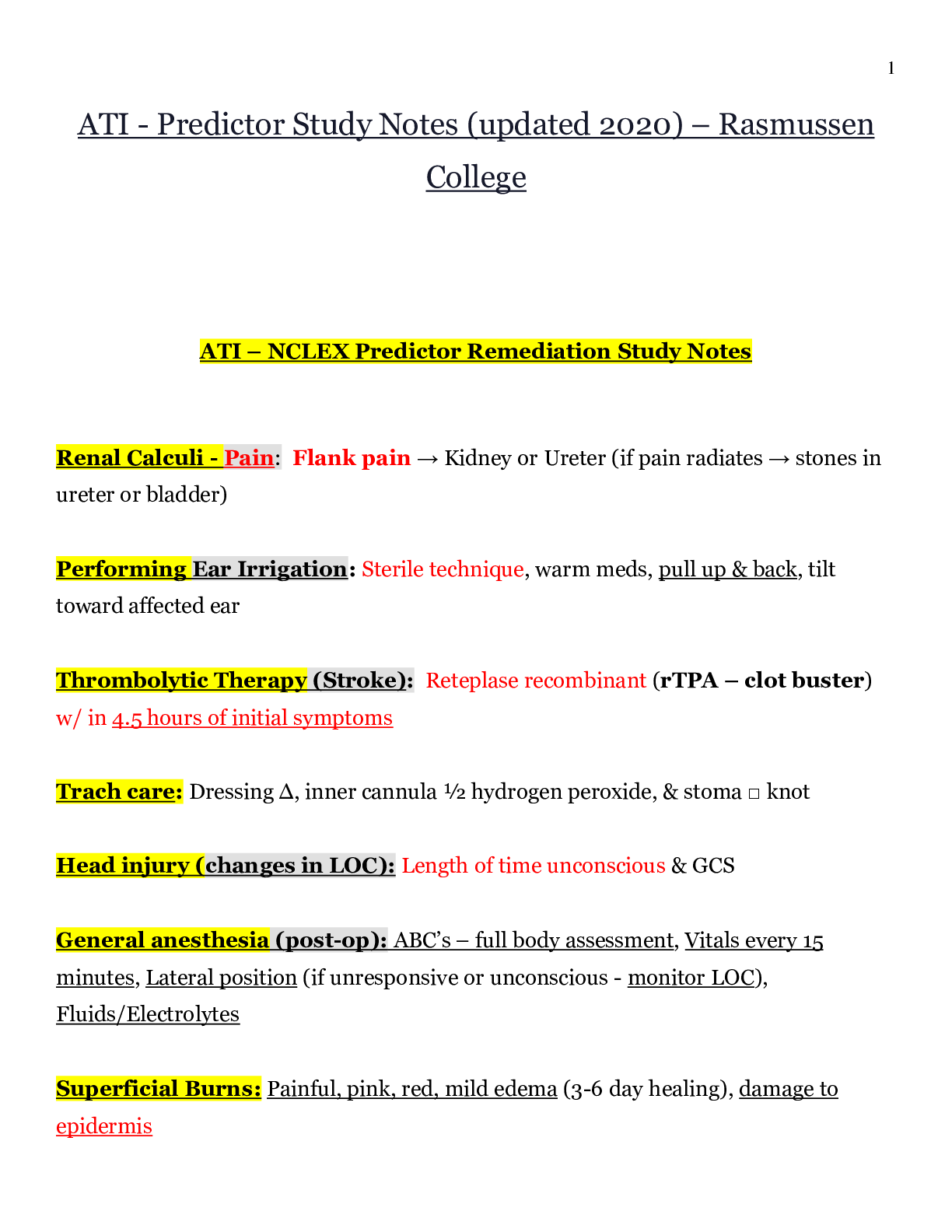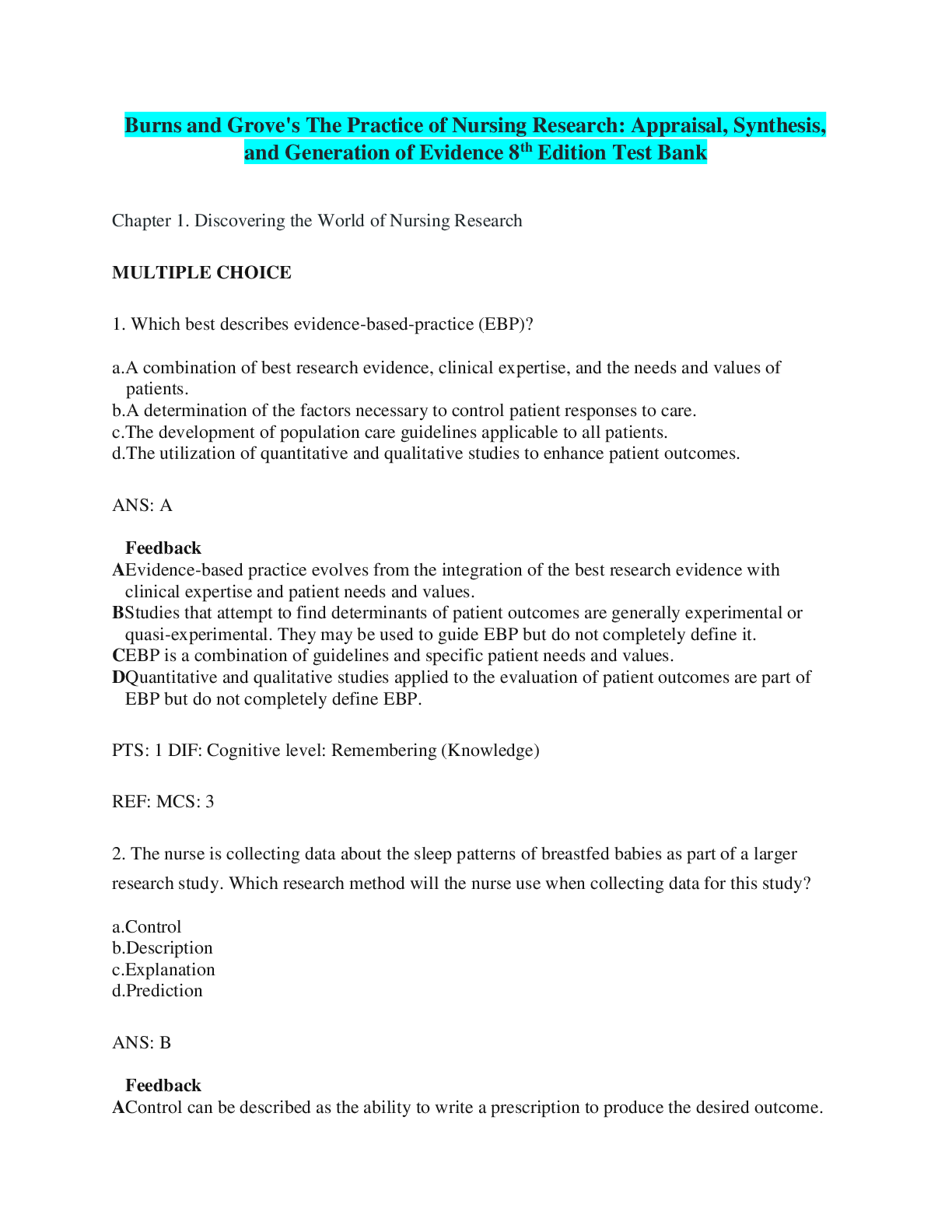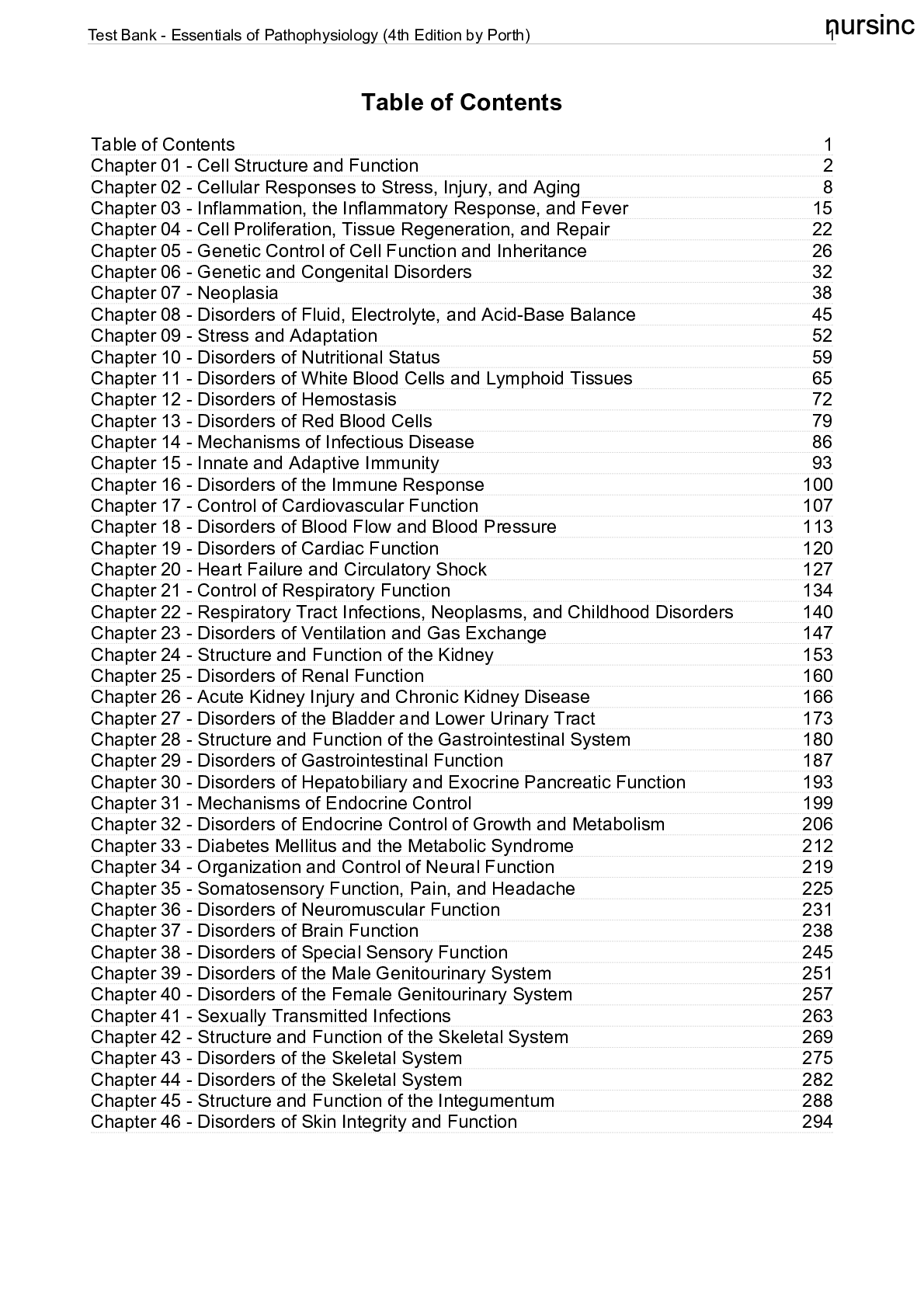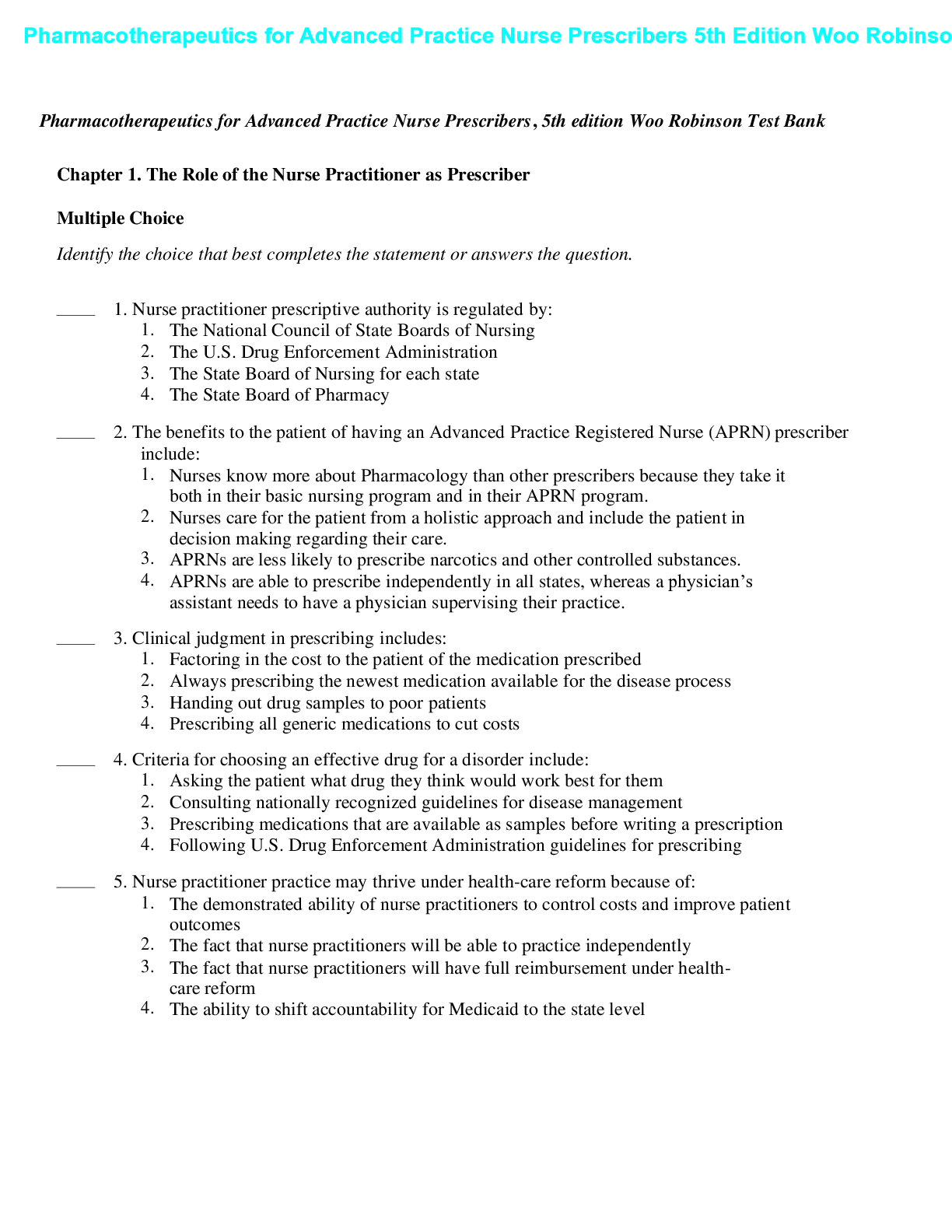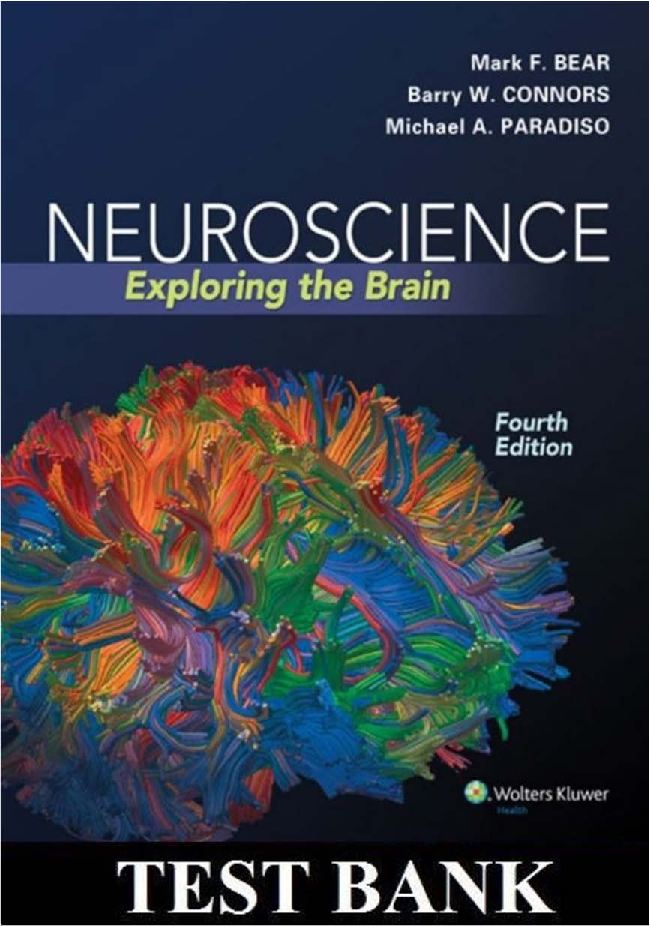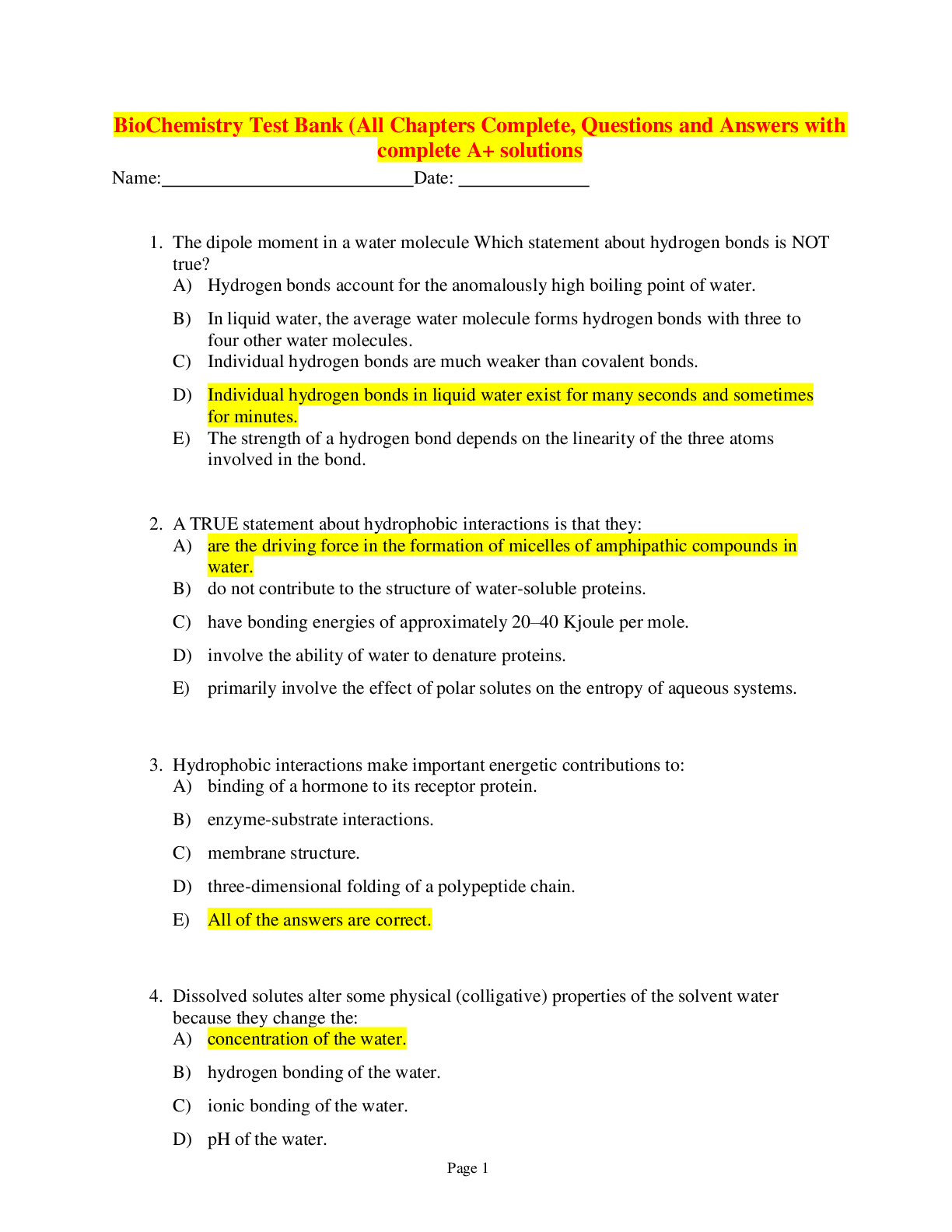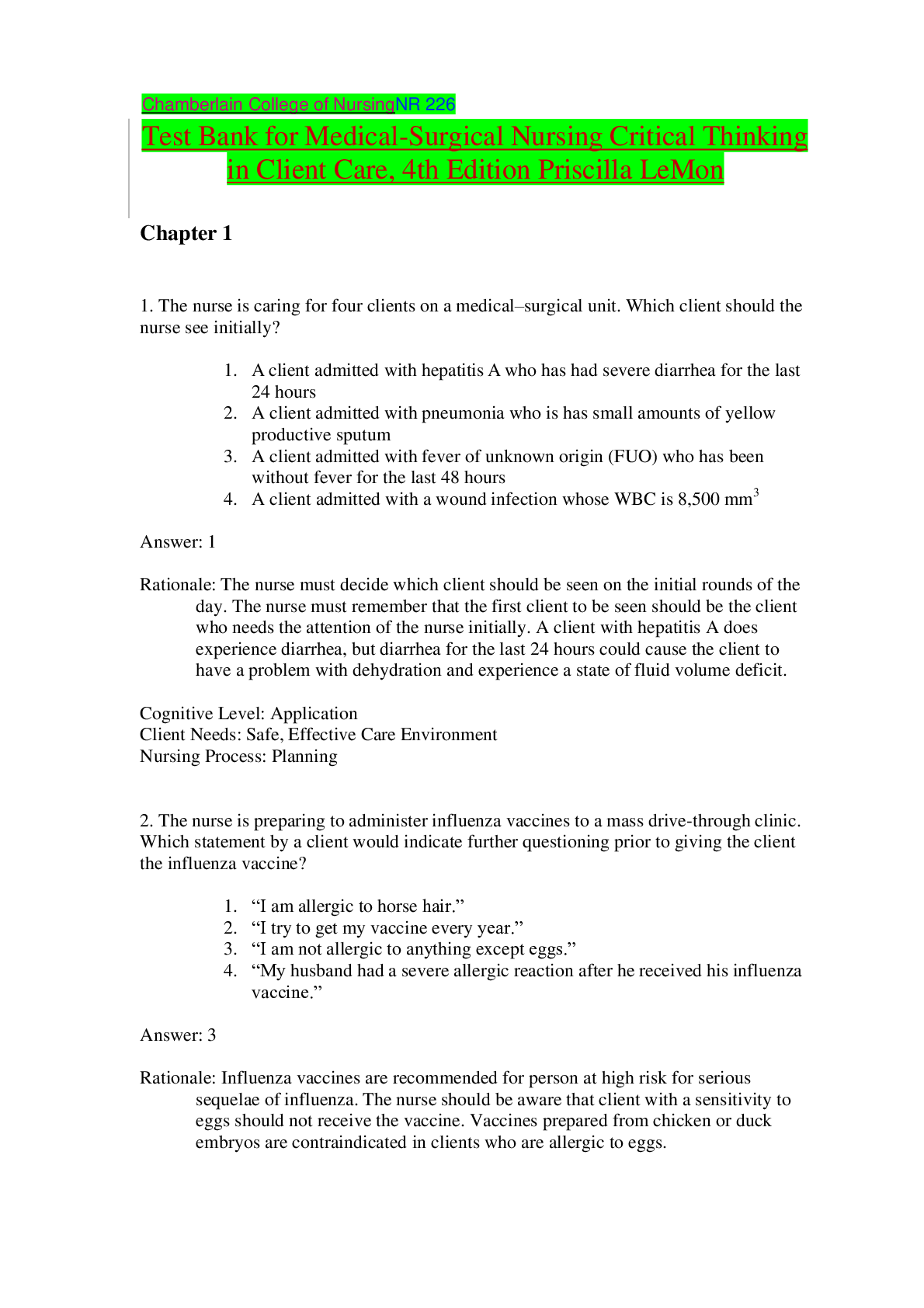Biology > TEST BANK > Campbell Biology 11th Edition Urry, Cain, Wasserman, Minorsky, Reece Test Bank (All chapters complet (All)
Campbell Biology 11th Edition Urry, Cain, Wasserman, Minorsky, Reece Test Bank (All chapters complete, Question and Answers)
Document Content and Description Below
Campbell Biology 11th Edition Urry, Cain, Wasserman, Minorsky, Reece Test Bank (All chapters complete, Question and Answers) Campbell Biology 11th Edition Urry, Cain, Wasserman, Minorsky, Reece Test ... Bank Campbell Biology, 11e (Urry) Chapter 1 Evolution, the Themes of Biology, and Scientific Inquiry 1.1 Multiple-Choice Questions 1) Cells are ________. A) only found in pairs, because single cells cannot exist independently B) limited in size to 200 and 500 micrometers in diameter C) characteristic of eukaryotic but not prokaryotic organisms D) characteristic of prokaryotic and eukaryotic organisms Answer: D Bloom's Taxonomy: Knowledge/Comprehension Section: 1.1 2) In comparison to eukaryotes, prokaryotes ________. A) are more structurally complex B) are larger C) are smaller D) do not have membranes Answer: C Bloom's Taxonomy: Knowledge/Comprehension Section: 1.1 3) Which of the following types of cells utilize deoxyribonucleic acid (DNA) as their genetic material but do not have their DNA encased within a nuclear envelope? A) animal B) plant C) archaean D) fungi Answer: C Bloom's Taxonomy: Application/Analysis Section: 1.1 4) To understand the chemical basis of inheritance, we must understand the molecular structure of DNA. This is an example of the application of which concept to the study of biology? A) evolution B) emergent properties C) reductionism D) feedback regulation Answer: C Bloom's Taxonomy: Application/Analysis Section: 1.1 2 Copyright © 2017 Pearson Education, Inc. 5) A localized group of organisms that belong to the same species is called a ________. A) community B) population C) ecosystem D) family Answer: B Bloom's Taxonomy: Knowledge/Comprehension Section: 1.1 6) Which of the following statements is true regarding the complexity of biological systems? A) An understanding of the interactions between different components within a living system is an approach towards understanding reductionism. B) Knowing the function of a component of a living system can provide insights into the structure and organization of the living system. C) Understanding the chemical structure of DNA reveals how it directs the functioning of a living cell. D) An ecosystem displays complex properties of the biotic component only. Answer: B Bloom's Taxonomy: Application/Analysis Section: 1.1 7) Which of the following order is correct in terms of the hierarchy of the organization? A) Ecosystem → Biosphere → Population → Community → Organism B) Biosphere → Ecosystem → Population → Community → Organism C) Ecosystem → Community → Biosphere → Population → Organism D) Biosphere → Ecosystem →Community → Population → Organism Answer: D Bloom's Taxonomy: Application/Analysis Section: 1.1 8) When your body temperature rises on a hot day, the neural and hormonal mechanisms activate sweating. Evaporation of sweat leads to cooling of the body surface. This is an example of ________. A) positive feedback regulation B) negative feedback regulation C) chemical cycling D) emergent properties Answer: B Bloom's Taxonomy: Application/Analysis Section: 1.1 3 Copyright © 2017 Pearson Education, Inc. 9) Characters are transmitted from parents to offspring. ________ are the units of inheritance. A) Genes B) Proteins C) RNA D) DNA Answer: A Bloom's Taxonomy: Knowledge/Comprehension Section: 1.1 10) As letters are to English language, ________ is/are to genetic information. A) proteins B) nucleotides C) DNA double helix D) A and B Answer: B Bloom's Taxonomy: Knowledge/Comprehension Section: 1.1 11) The process by which the information in a gene directs the synthesis of a protein is called ________. A) gene expression B) replication C) post translation modification D) cloning Answer: A Bloom's Taxonomy: Application/Analysis Section: 1.2 12) Which of the following statements is true? A) mRNA is the only type of RNA found in the living system B) All forms of life employ the same genetic code C) A typical human liver cell has one set of chromosomes D) Organisms interact but do not affect their environment Answer: B Bloom's Taxonomy: Knowledge/Comprehension Section: 1.2 13) Plants convert ________. A) chemical energy to mechanical energy. B) sunlight to mechanical energy. C) sunlight to chemical energy. D) mechanical energy to chemical energy. Answer: C Bloom's Taxonomy: Knowledge/Comprehension Section: 1.2 4 Copyright © 2017 Pearson Education, Inc. 14) Which of these provides evidence of the common ancestry of all life? A) near universality of the genetic code B) structure of the nucleus C) structure of cilia D) structure of chloroplasts Answer: A Bloom's Taxonomy: Application/Analysis Section: 1.2 15) Which branch of biology is concerned with the naming and classifying of organisms? A) informatics B) taxonomy C) genomics D) evolution Answer: B Bloom's Taxonomy: Knowledge/Comprehension Section: 1.2 16) Use the following figure to answer the question. The phylogenetic tree ________. A) depicts that Archaea is closer to Bacteria than Eukarya B) depicts that Eukarya is closer to Bacteria than Archaea C) includes unicellular and some forms of multicellular life, but not complex animals and plants D) includes every single life form on this earth Answer: D Bloom's Taxonomy: Application/Analysis Section: 1.2 5 Copyright © 2017 Pearson Education, Inc. 17) Use the following figure to answer the question. "A" is ________; "B" is ________. A) the most recent species to evolve on Earth; an ancestor of group "A" B) the most recent species to evolve on Earth; the last common ancestor of Archaea and Eukarya C) the common ancestor of all life; the common ancestor of Bacteria and Archaea D) the common ancestor of all life; the last common ancestor of Archaea and Eukarya Answer: D Bloom's Taxonomy: Application/Analysis Section: 1.2 18) You are suffering from Streptococcus throat infection. You share the following with the bacteria that is responsible for your condition. A) You both belong to the same domain. B) You both are made up of cells. C) You both have genetic material in your nucleus. D) You and Streptococcus have nothing in common. Answer: B Bloom's Taxonomy: Application/Analysis Section: 1.2 19) Which of the following is true of natural selection? A) It requires genetic variation. B) It results in descent with modification. C) It involves differential reproductive success. D) It requires genetic variation, results in descent with modification, and involves differential reproductive success. Answer: D Bloom's Taxonomy: Knowledge/Comprehension Section: 1.2 20) Which of the following is not one of Charles Darwin's observations? A) Individuals in a population vary in their traits. B) Many of the traits in an individual are heritable. C) A population avoids competition by producing only as many offspring as can successfully reproduce on their own. D) Species generally are adapted to their environments. Answer: C Bloom's Taxonomy: Knowledge/Comprehension Section: 1.2 6 Copyright © 2017 Pearson Education, Inc. 21) The evolution of one species into two or more species as a result of different populations becoming reproductively isolated from each other is best termed as ________. A) adaptive radiation B) creationism C) natural selection D) prototype Answer: A Bloom's Taxonomy: Knowledge/Comprehension Section: 1.2 22) Cotton-topped tamarins are small primates with tufts of long white hair on their heads. While studying these creatures, you notice that males with longer hair get more opportunities to mate and father more offspring. To test the hypothesis that having longer hair is adaptive in these males, you should ________. A) test whether other traits in these males are also adaptive B) look for evidence of hair in ancestors of tamarins C) determine if hair length is heritable D) test whether males with shaved heads are still able to mate Answer: C Bloom's Taxonomy: Application/Analysis Section: 1.2 23) Following a scientific method, which of the following is the correct order of steps? A) Observation → Analysis → Hypothesis → Conclusion → Communicate results → Experiment B) Observation → Hypothesis → Experiment → Communicate results → Analysis → Conclusion C) Experiment → Hypothesis → Observation → Analysis → Conclusion → Communicate results D) Observation → Hypothesis → Experiment → Analysis → Conclusion → Communicate results Answer: D Bloom's Taxonomy: Knowledge/Comprehension Section: 1.3 24) Which of the following questions is considered a thought-provoking scientific query? A) How long ago did the Pterosaurs live on this planet? B) Does the amount of solute in water affect the boiling point of the solution? C) Who invented the telescope? D) How many tigers are left in India? Answer: D Bloom's Taxonomy: Application/Analysis Section: 1.1 7 Copyright © 2017 Pearson Education, Inc. 25) The following experiment is used for the following question. A researcher discovered a species of moth that lays its eggs on oak trees. Eggs are laid at two distinct times of the year: early in spring when the oak trees are flowering and in midsummer when flowering is past. Caterpillars from eggs that hatch in spring feed on oak flowers and look like oak flowers, but caterpillars that hatch in summer feed on oak leaves and look like oak twigs. How does the same population of moths produce such different-looking caterpillars on the same trees? To answer this question, the biologist caught many female moths from the same population and collected their eggs. He put at least one egg from each female into eight identical cups. The eggs hatched, and at least two larvae from each female were maintained in one of the four temperature and light conditions listed below. Temperature Day Length Springlike Springlike Springlike Summerlike Summerlike springlike Summerlike summerlike In each of the four environments, one of the caterpillars was fed oak flowers, the other oak leaves. Thus, there were a total of eight treatment groups (4 environments × 2 diets). Which one of the following is not a plausible hypothesis that can be tested in this experiment? A) The longer day lengths of summer trigger the development of twig-like caterpillars. B) The cooler temperatures of spring trigger the development of flowerlike caterpillars. C) Differences in air pressure, due to differences in elevation, trigger the development of different types of caterpillars. D) Differences in diet trigger the development of different types of caterpillars. Answer: C Bloom's Taxonomy: Application/Analysis Section: 1.3 8 Copyright © 2017 Pearson Education, Inc. 26) The following experiment is used for the following question. A researcher discovered a species of moth that lays its eggs on oak trees. Eggs are laid at two distinct times of the year: early in spring when the oak trees are flowering and in midsummer when flowering is past. Caterpillars from eggs that hatch in spring feed on oak flowers and look like oak flowers, but caterpillars that hatch in summer feed on oak leaves and look like oak twigs. How does the same population of moths produce such different-looking caterpillars on the same trees? To answer this question, the biologist caught many female moths from the same population and collected their eggs. He put at least one egg from each female into eight identical cups. The eggs hatched, and at least two larvae from each female were maintained in one of the four temperature and light conditions listed below. Temperature Day Length Springlike Springlike Springlike Summerlike Summerlike springlike Summerlike summerlike In each of the four environments, one of the caterpillars was fed oak flowers, the other oak leaves. Thus, there were a total of eight treatment groups (4 environments × 2 diets). In every case, caterpillars that feed on oak flowers look like oak flowers. In every case, caterpillars that were raised on oak leaves looked like twigs. These results support which of the following hypotheses? A) The longer day lengths of summer trigger the development of twig-like caterpillars. B) Differences in air pressure, due to elevation, trigger the development of different types of caterpillars. C) Differences in diet trigger the development of different types of caterpillars. D) The differences are genetic. A female will either produce all flowerlike caterpillars or all twig-like caterpillars. Answer: C Bloom's Taxonomy: Application/Analysis Section: 1.3 9 Copyright © 2017 Pearson Education, Inc. 27) The following experiment is used for the following question. A researcher discovered a species of moth that lays its eggs on oak trees. Eggs are laid at two distinct times of the year: early in spring when the oak trees are flowering and in midsummer when flowering is past. Caterpillars from eggs that hatch in spring feed on oak flowers and look like oak flowers, but caterpillars that hatch in summer feed on oak leaves and look like oak twigs. How does the same population of moths produce such different-looking caterpillars on the same trees? To answer this question, the biologist caught many female moths from the same population and collected their eggs. He put at least one egg from each female into eight identical cups. The eggs hatched, and at least two larvae from each female were maintained in one of the four temperature and light conditions listed below. Temperature Day Length Springlike Springlike Springlike Summerlike Summerlike springlike Summerlike summerlike In each of the four environments, one of the caterpillars was fed oak flowers, the other oak leaves. Thus, there were a total of eight treatment groups (4 environments × 2 diets). Recall that eggs from the same female were exposed to each of the eight treatments used. This aspect of the experimental design tested which of the following hypotheses? A) The longer day lengths of summer trigger the development of twig-like caterpillars. B) Differences in air pressure, due to elevation, trigger the development of different types of caterpillars. C) Differences in diet trigger the development of different types of caterpillars. D) The differences are genetic. A female will either produce all flowerlike caterpillars or all twig-like caterpillars. Answer: D Bloom's Taxonomy: Application/Analysis Section: 1.3 10 Copyright © 2017 Pearson Education, Inc. 28) The following experiment is used for the following question. A researcher discovered a species of moth that lays its eggs on oak trees. Eggs are laid at two distinct times of the year: early in spring when the oak trees are flowering and in midsummer when flowering is past. Caterpillars from eggs that hatch in spring feed on oak flowers and look like oak flowers, but caterpillars that hatch in summer feed on oak leaves and look like oak twigs. How does the same population of moths produce such different-looking caterpillars on the same trees? To answer this question, the biologist caught many female moths from the same population and collected their eggs. He put at least one egg from each female into eight identical cups. The eggs hatched, and at least two larvae from each female were maintained in one of the four temperature and light conditions listed below. Temperature Day Length Springlike Springlike Springlike Summerlike Summerlike springlike Summerlike summerlike In each of the four environments, one of the caterpillars was fed oak flowers, the other oak leaves. Thus, there were a total of eight treatment groups (4 environments × 2 diets). Recall that in the experiment, caterpillars born in the spring looked like flowers, and caterpillars born in the summer looked like twigs. What is the most likely selective advantage for this difference in body shape? A) Looking like their food sources allows the caterpillars to move through their environment more efficiently. B) Development into the adult moth form is faster for caterpillars shaped like twigs than like flowers. C) Looking like their food source lets the caterpillars blend into their surroundings, reducing predation. D) Looking like their food source will increase the caterpillars' feeding efficiency; this would increase their growth rate and survival rate. Answer: C Bloom's Taxonomy: Application/Analysis Section: 1.3 11 Copyright © 2017 Pearson Education, Inc. 29) How does a scientific theory differ from a scientific hypothesis? A) Theories are proposed to test scientific hypotheses. B) Theories are usually an explanation for a more general phenomenon; hypotheses typically address more specific issues. C) Hypotheses are usually an explanation for a more general phenomenon; theories typically address more specific issues. D) Confirmed theories become scientific laws; hypotheses become theories. Answer: B Bloom's Taxonomy: Knowledge/Comprehension Section: 1.3 30) A friend of yours calls to say that his car would not start this morning. He asks for your help. You say that you think the battery must be dead. If so, then jump-starting the car from a good battery will solve the problem. In doing so, you are ________. A) testing a theory for why the car will not start B) making observations to inspire a theory for why the car will not start C) stating a hypothesis and using that hypothesis to make a testable prediction D) comparing multiple hypotheses for why the car will not start Answer: C Bloom's Taxonomy: Application/Analysis Section: 1.3 31) Agrobacterium infects plants and causes them to form tumors. You are asked to determine how long a plant must be exposed to these bacteria to become infected. Which of the following experiments will provide the best data to address that question? A) Determine the survival rate of Agrobacterium when exposed to different concentrations of an antibiotic. B) Measure the number of tumors formed on a plant when exposed to various concentrations of Agrobacterium. C) Measure the concentration of Agrobacterium in different soil environments where the plants grow. D) Measure the number of tumors formed on plants, which are exposed to Agrobacterium for different lengths of time. Answer: D Bloom's Taxonomy: Application/Analysis Section: 1.3 12 Copyright © 2017 Pearson Education, Inc. 32) Agrobacterium infects plants and causes them to form tumors. You determine that tumor formation requires a large amount of the plant's energy for tissue formation. How might this change the number of offspring a plant produces, and what is the most likely explanation for this change? A) The number of offspring should increase because in general, illness increases the reproductive output of organisms. B) The number of offspring should increase because the bacteria will provide energy for the plant. C) The number of offspring should decrease because the plant will divert energy from reproduction to tumor formation. D) There should be no effect of infection on offspring production because energy for reproduction is independent of infection. Answer: C Bloom's Taxonomy: Application/Analysis Section: 1.3 [Show More]
Last updated: 11 months ago
Preview 1 out of 472 pages

Reviews( 0 )
Document information
Connected school, study & course
About the document
Uploaded On
Sep 08, 2021
Number of pages
472
Written in
Additional information
This document has been written for:
Uploaded
Sep 08, 2021
Downloads
0
Views
46

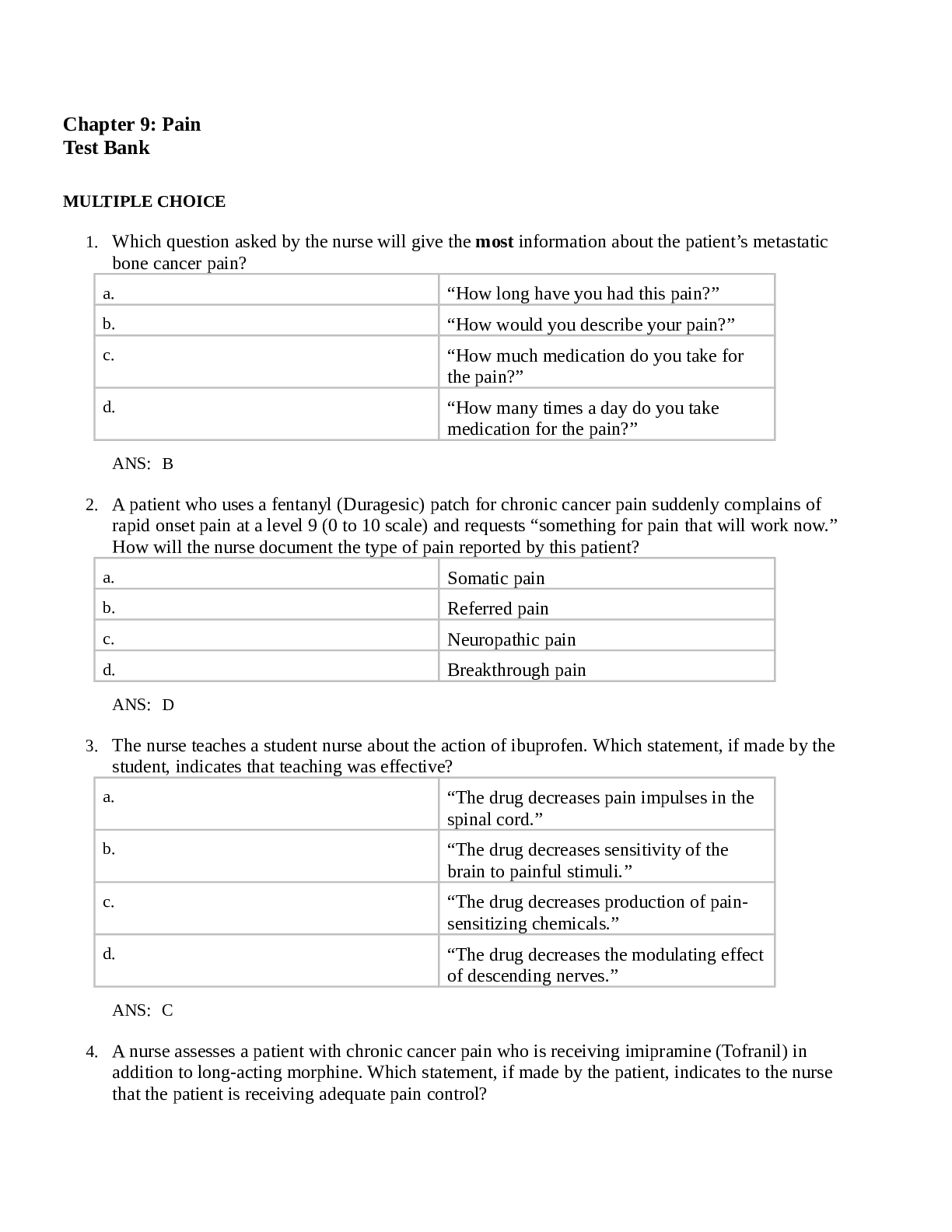


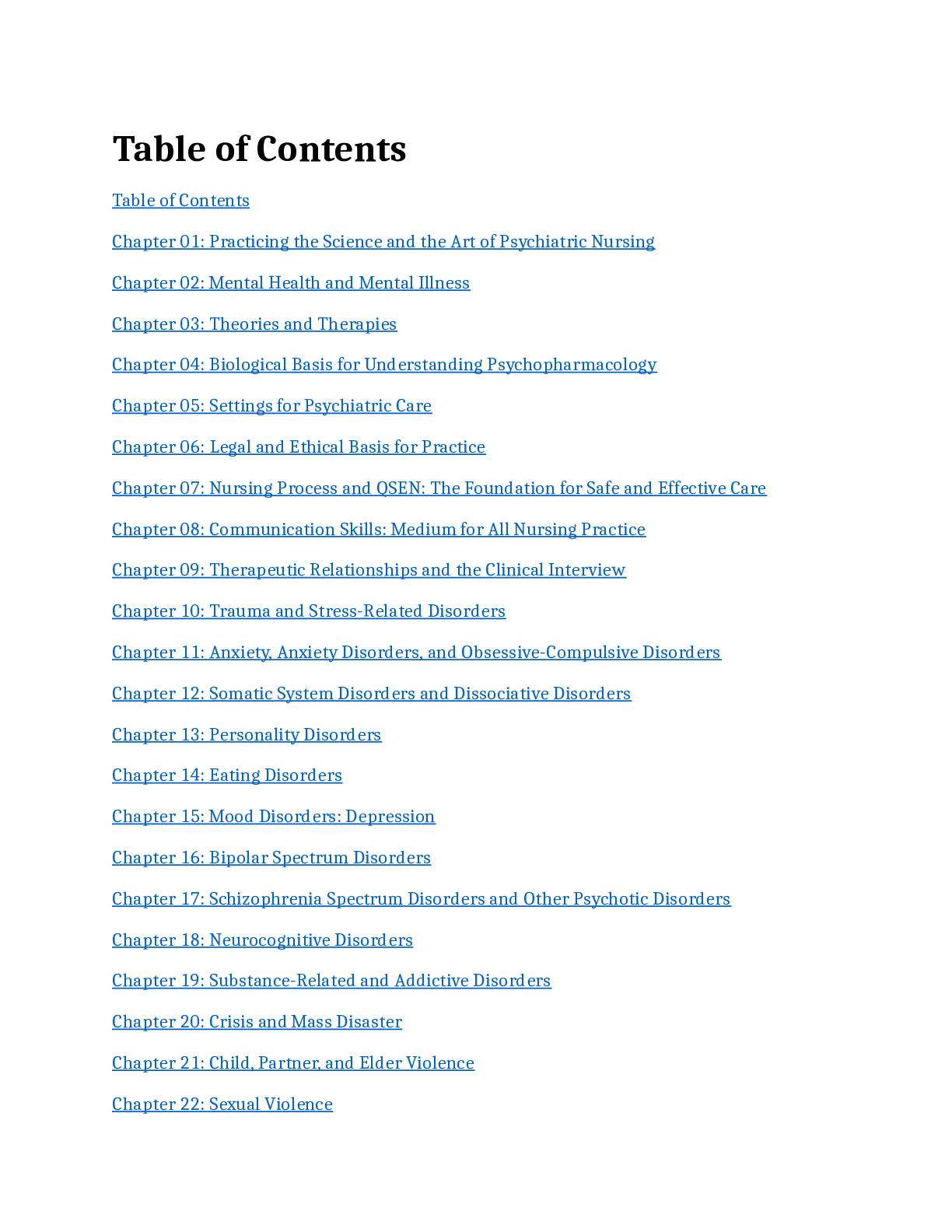
.png)


